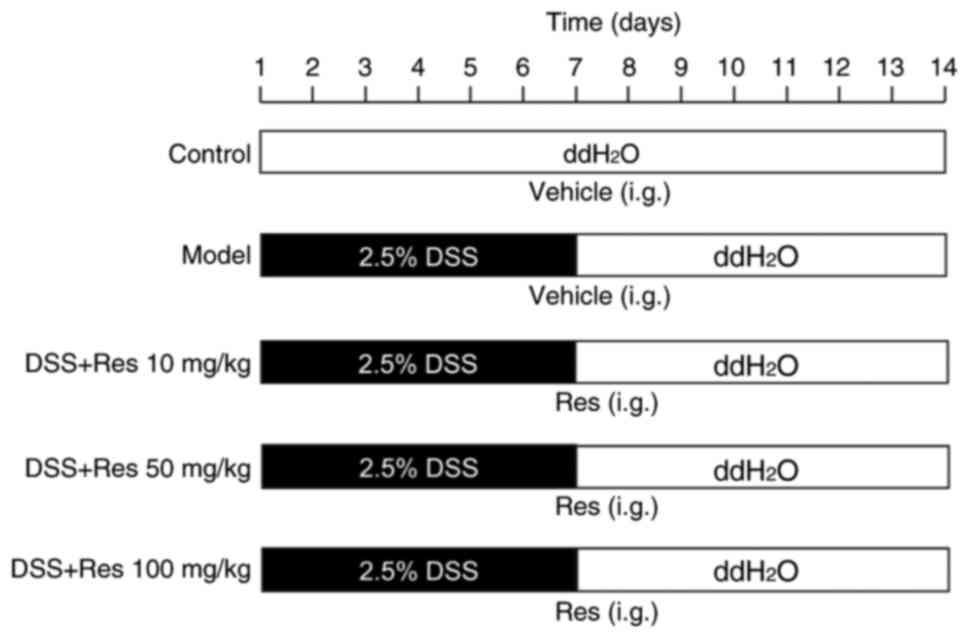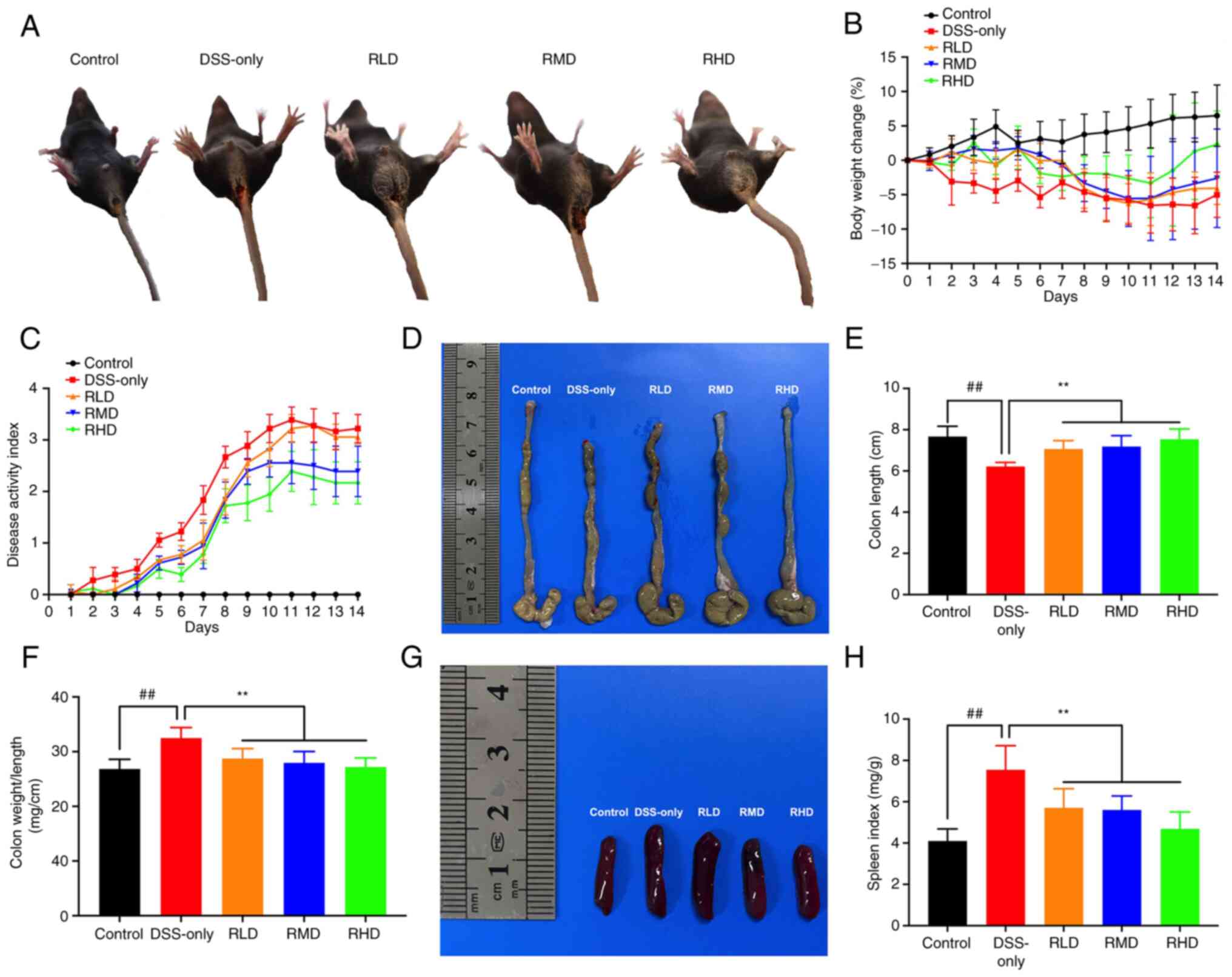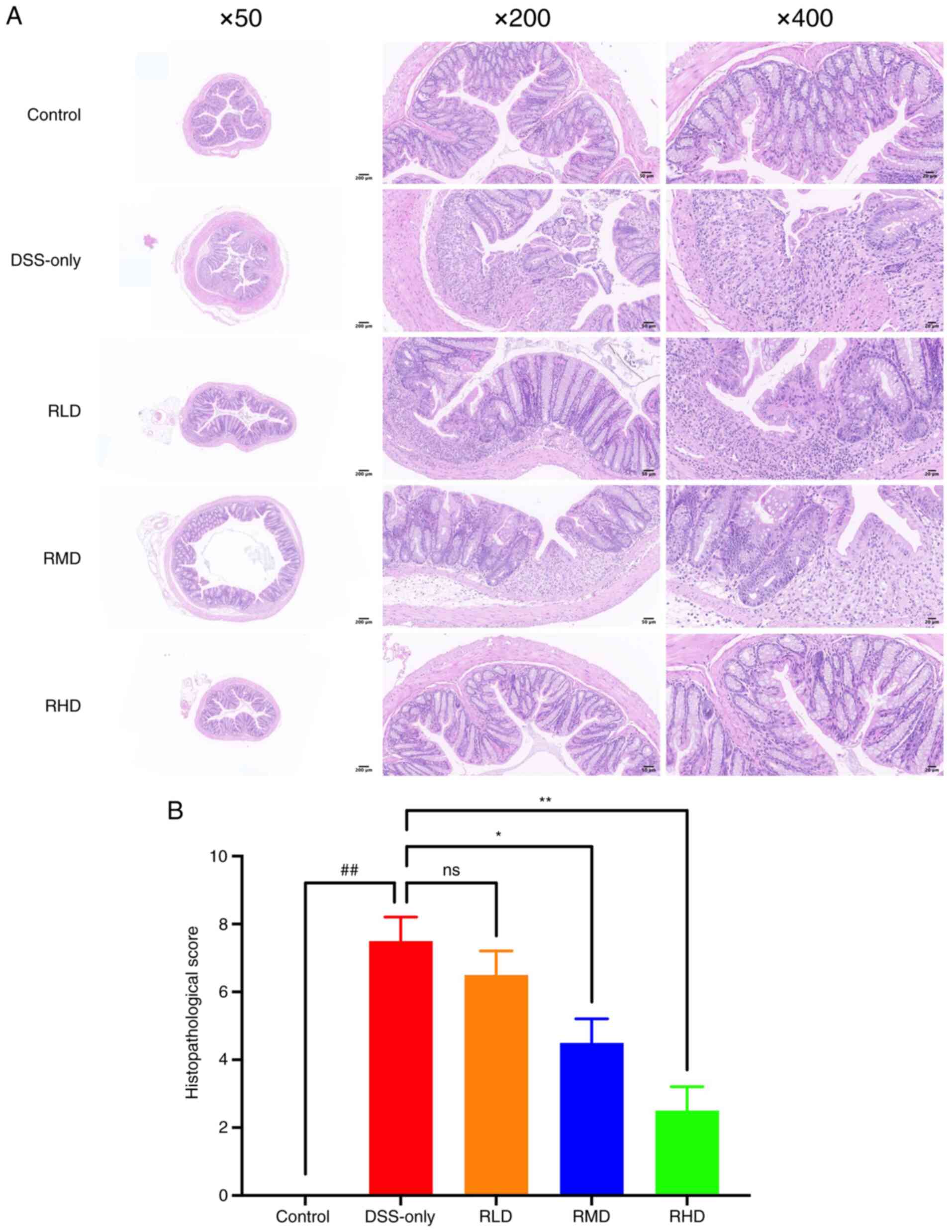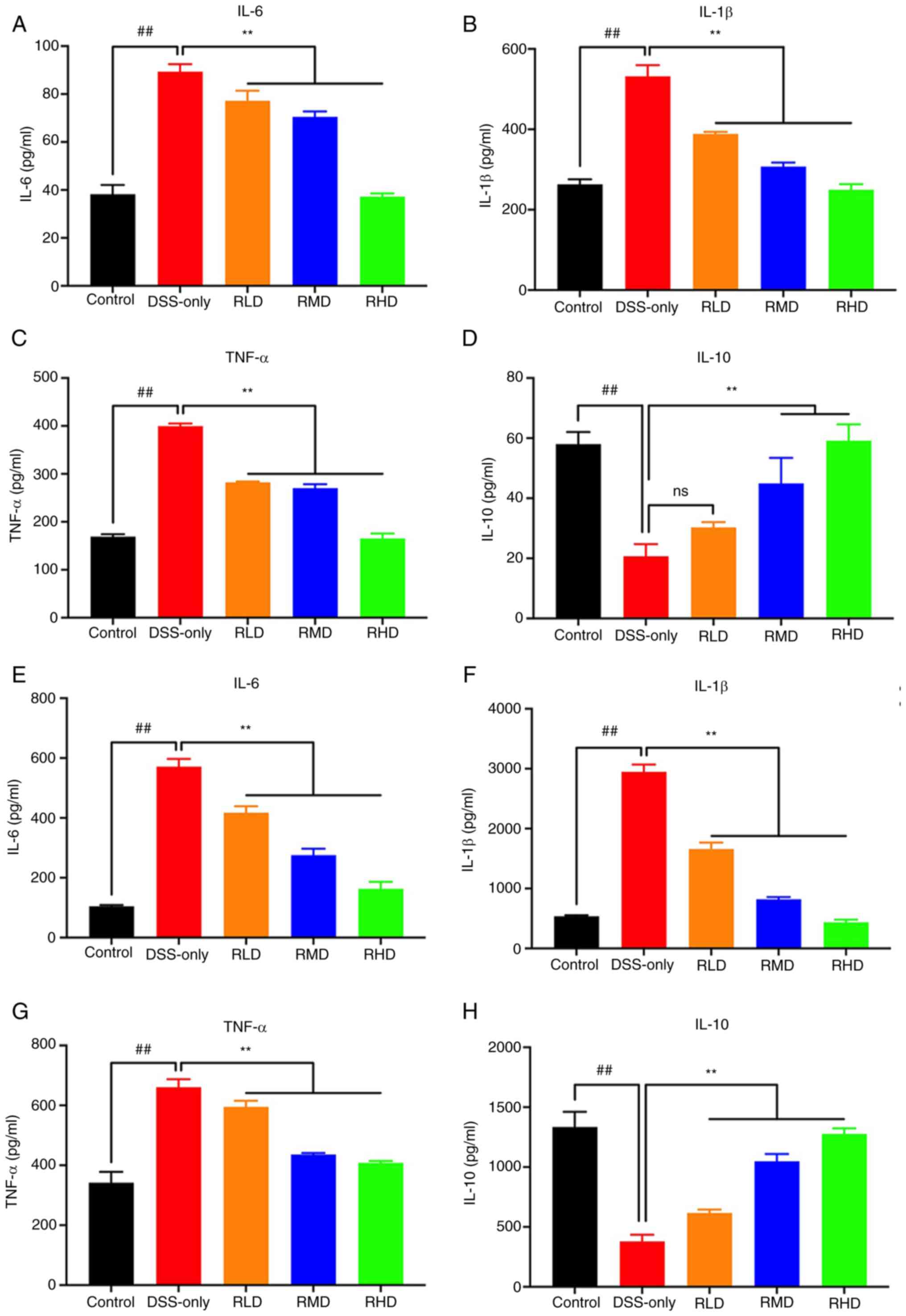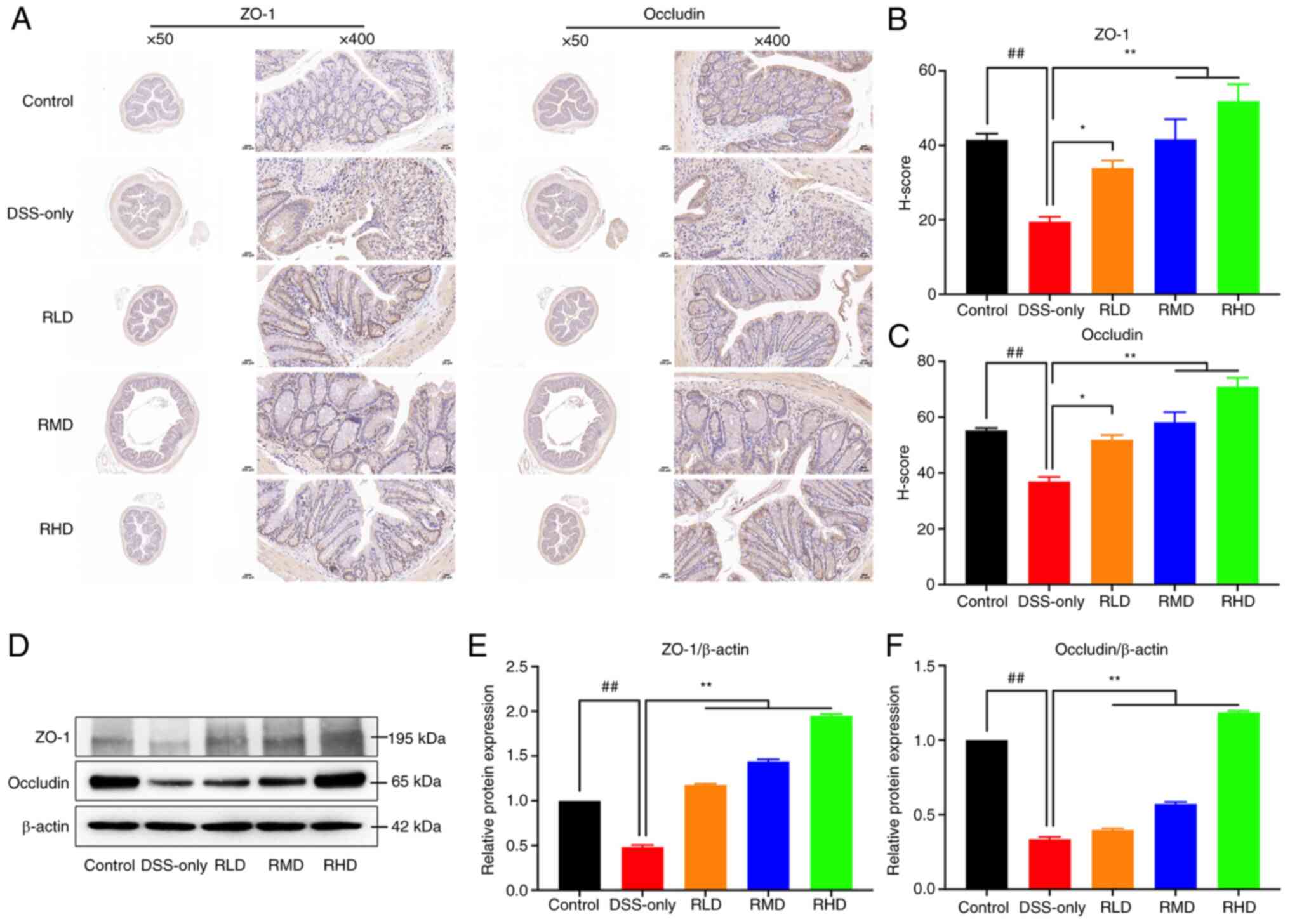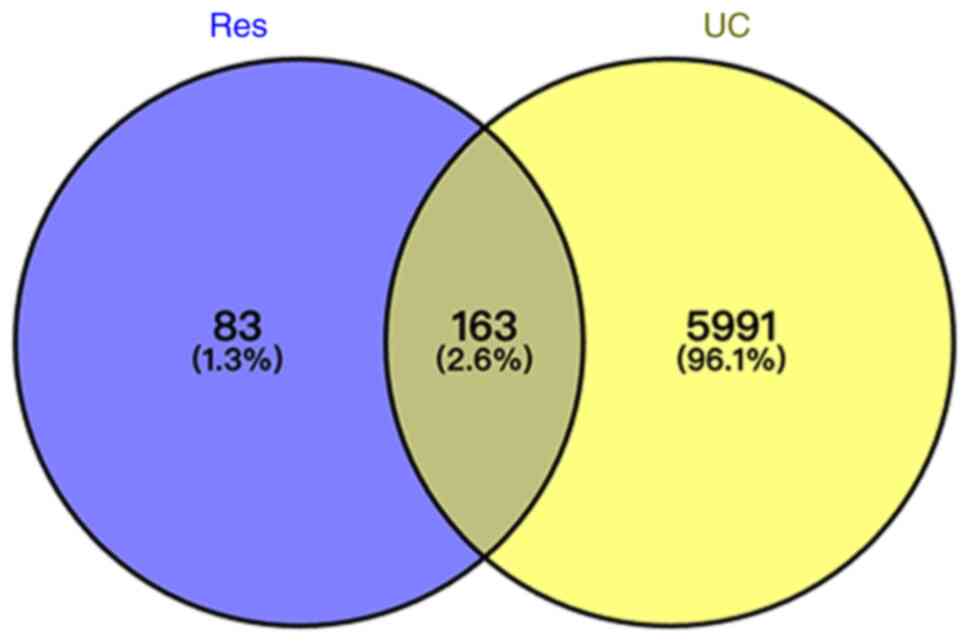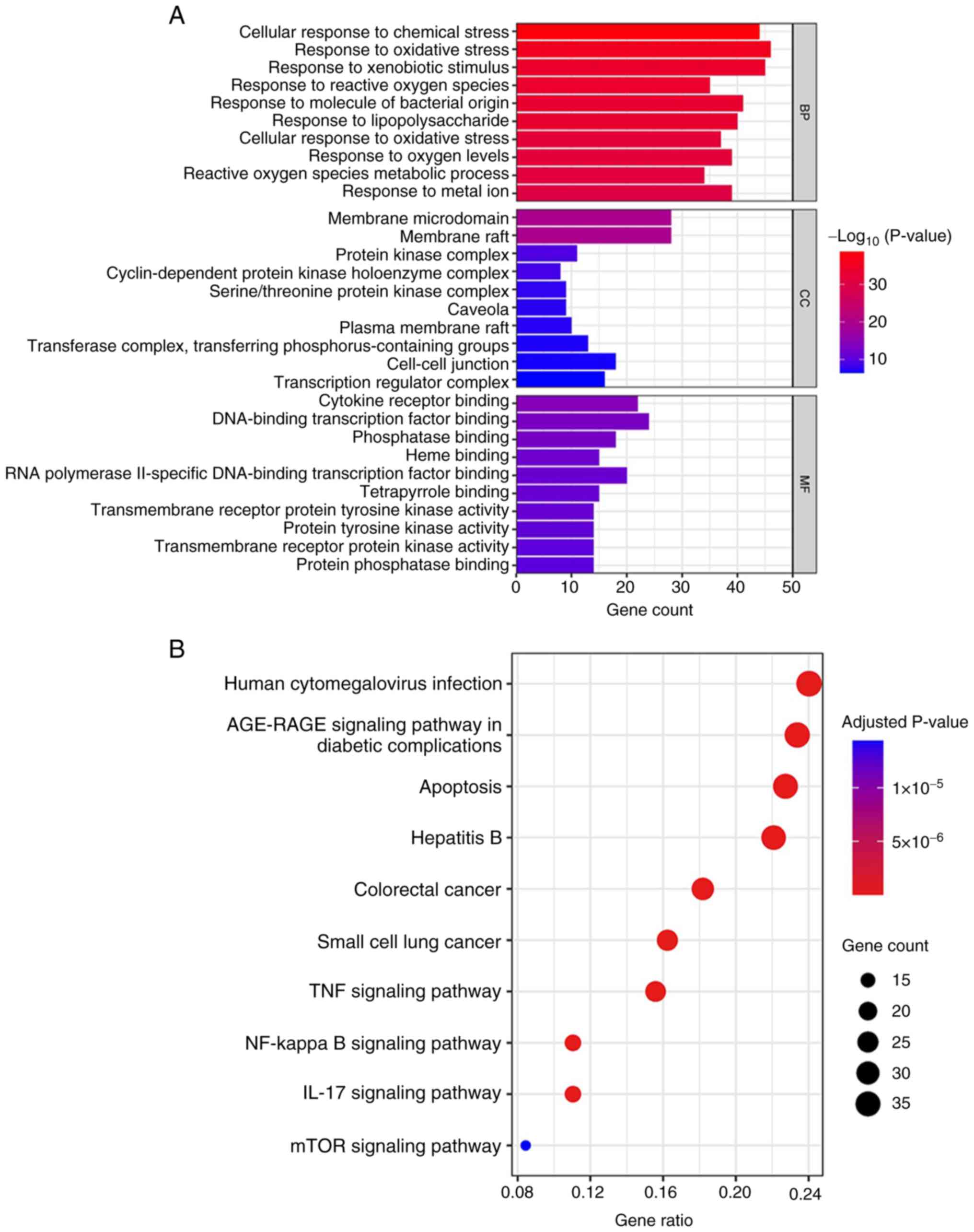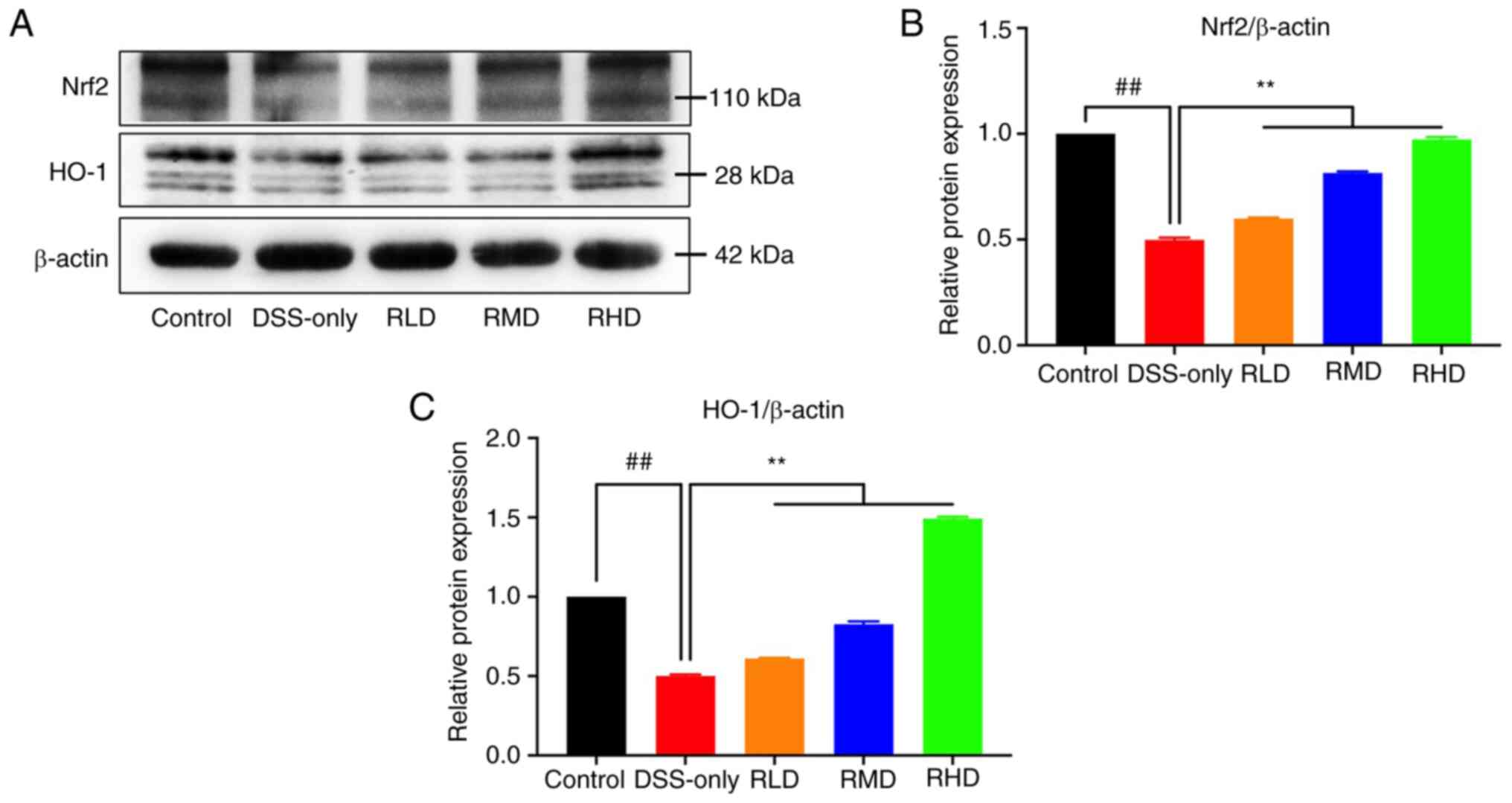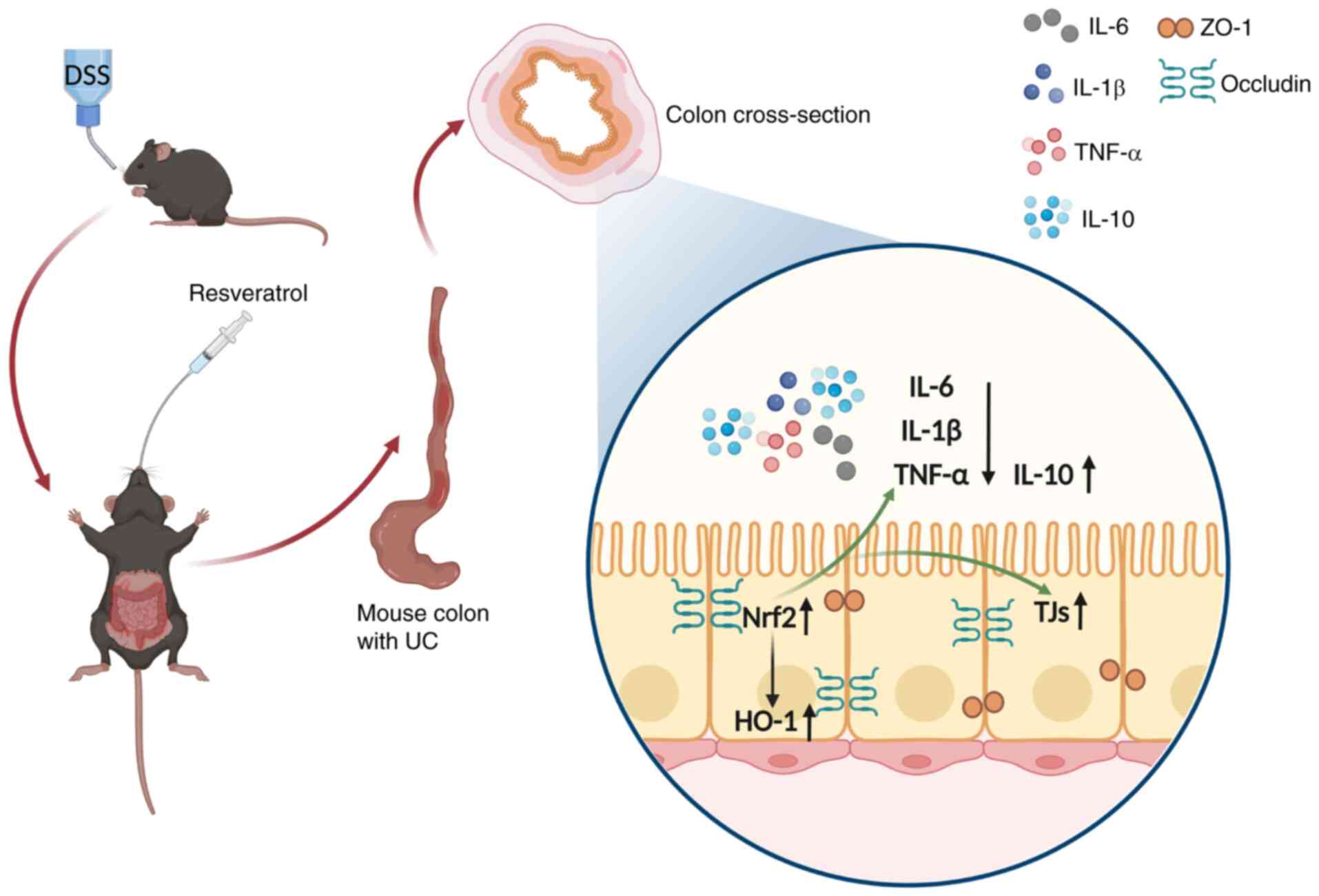|
1
|
Shah SC and Itzkowitz SH: Colorectal
cancer in inflammatory bowel disease: Mechanisms and management.
Gastroenterol. 162:715–730.e3. 2022. View Article : Google Scholar : PubMed/NCBI
|
|
2
|
Tili E, Michaille JJ, Piurowski V, Rigot B
and Croce CM: MicroRNAs in intestinal barrier function,
inflammatory bowel disease and related cancers-their effects and
therapeutic potentials. Curr Opin Pharmacol. 37:142–150. 2017.
View Article : Google Scholar : PubMed/NCBI
|
|
3
|
Kobayashi T, Siegmund B, Le Berre C, Wei
SC, Ferrante M, Shen B, Bernstein CN, Danese S, Peyrin-Biroulet L
and Hibi T: Ulcerative colitis. Nat Rev Dis Primers. 6:742020.
View Article : Google Scholar : PubMed/NCBI
|
|
4
|
Ungaro R, Mehandru S, Allen PB,
Peyrin-Biroulet L and Colombel JF: Ulcerative colitis. Lancet.
389:1756–1770. 2017. View Article : Google Scholar : PubMed/NCBI
|
|
5
|
Garcia-Planella E, Mañosa M, Van Domselaar
M, Gordillo J, Zabana Y, Cabré E, López San Román A and Domènech E:
Long-term outcome of ulcerative colitis in patients who achieve
clinical remission with a first course of corticosteroids. Dig
Liver Dis. 44:206–210. 2012. View Article : Google Scholar : PubMed/NCBI
|
|
6
|
Hoffmann P, Wehling C, Krisam J,
Pfeiffenberger J, Belling N and Gauss A: Performance of tacrolimus
in hospitalized patients with steroid-refractory acute severe
ulcerative colitis. World J Gastroenterol. 25:1603–1617. 2019.
View Article : Google Scholar : PubMed/NCBI
|
|
7
|
Vindigni SM, Zisman TL, Suskind DL and
Damman CJ: The intestinal microbiome, barrier function, and immune
system in inflammatory bowel disease: A tripartite
pathophysiological circuit with implications for new therapeutic
directions. Therap Adv Gastroenterol. 9:606–625. 2016. View Article : Google Scholar : PubMed/NCBI
|
|
8
|
Odenwald MA and Turner JR: The intestinal
epithelial barrier: A therapeutic target? Nat Rev Gastroenterol
Hepatol. 14:9–21. 2017. View Article : Google Scholar : PubMed/NCBI
|
|
9
|
Keane TJ, Dziki J, Sobieski E, Smoulder A,
Castleton A, Turner N, White LJ and Badylak SF: Restoring mucosal
barrier function and modifying macrophage phenotype with an
extracellular matrix hydrogel: Potential therapy for ulcerative
colitis. J Crohns Colitis. 11:360–368. 2017.PubMed/NCBI
|
|
10
|
Sina C, Kemper C and Derer S: The
intestinal complement system in inflammatory bowel disease: Shaping
intestinal barrier function. Semin Immunol. 37:66–73. 2018.
View Article : Google Scholar : PubMed/NCBI
|
|
11
|
Chagas MDSS, Behrens MD, Moragas-Tellis
CJ, Penedo GXM, Silva AR and Gonçalves-de-Albuquerque CF: Flavonols
and flavones as potential anti-inflammatory, antioxidant, and
antibacterial compounds. Oxid Med Cell Longev. 2022:99667502022.
View Article : Google Scholar : PubMed/NCBI
|
|
12
|
Kim HH, Jeong SH, Park MY, Bhosale PB,
Abusaliya A, Kim HW, Seong JK, Kim DI, Lee SJ, Park KI and Kim GS:
Potential antioxidant and anti-inflammatory properties of
polyphenolic compounds from cirsium japonicum extract. Int J Mol
Sci. 25:7852024. View Article : Google Scholar : PubMed/NCBI
|
|
13
|
Javid AZ, Hormoznejad R, Yousefimanesh HA,
Haghighi-Zadeh MH and Zakerkish M: Impact of resveratrol
supplementation on inflammatory, antioxidant, and periodontal
markers in type 2 diabetic patients with chronic periodontitis.
Diabetes Metab Syndr. 13:2769–2774. 2019. View Article : Google Scholar : PubMed/NCBI
|
|
14
|
Zimmermann-Franco DC, Esteves B, Lacerda
LM, Souza IdO, Santos JAD, Pinto NdCC, Scio E, da Silva AD and
Macedo GC: In vitro and in vivo anti-inflammatory properties of
imine resveratrol analogues. Bioorg Med Chem. 26:4898–4906. 2018.
View Article : Google Scholar : PubMed/NCBI
|
|
15
|
Samsami-Kor M, Daryani NE, Asl PR and
Hekmatdoost A: Anti-inflammatory effects of resveratrol in patients
with ulcerative colitis: A randomized, double-blind,
placebo-controlled pilot study. Arch Med Res. 46:280–285. 2015.
View Article : Google Scholar : PubMed/NCBI
|
|
16
|
Samsamikor M, Daryani NE, Asl PR and
Hekmatdoost A: Resveratrol supplementation and
oxidative/anti-oxidative status in patients with ulcerative
colitis: A randomized, double-blind, placebo-controlled pilot
study. Arch Med Res. 47:304–309. 2016. View Article : Google Scholar : PubMed/NCBI
|
|
17
|
Stefanson AL and Bakovic M: Dietary
regulation of Keap1/Nrf2/ARE pathway: Focus on plant-derived
compounds and trace minerals. Nutrients. 6:3777–3801. 2014.
View Article : Google Scholar : PubMed/NCBI
|
|
18
|
Huang W, Zhong Y, Gao B, Zheng B and Liu
Y: Nrf2-mediated therapeutic effects of dietary flavones in
different diseases. Front Pharmacol. 14:12404332023. View Article : Google Scholar : PubMed/NCBI
|
|
19
|
Korytina GF, Akhmadishina LZ, Aznabaeva
YG, Kochetova OV, Zagidullin NS, Kzhyshkowska JG, Zagidullin SZ and
Viktorova TV: Associations of the NRF2/KEAP1 pathway and
antioxidant defense gene polymorphisms with chronic obstructive
pulmonary disease. Gene. 692:102–112. 2019. View Article : Google Scholar : PubMed/NCBI
|
|
20
|
Somparn N, Prawan A, Senggunprai L,
Kukongviriyapan U, Jetsrisuparb A, Lee MH, Kim DH, Kukongviriyapan
V and Surh YJ: Cellular adaptation mediated through Nrf2-induced
glutamate cysteine ligase up-regulation against oxidative stress
caused by iron overload in β-thalassemia/HbE patients. Free Radic
Res. 53:791–799. 2019. View Article : Google Scholar : PubMed/NCBI
|
|
21
|
Zhang Z, Ni P, Tang M, Song Y, Liu C and
Zhao B: Dapagliflozin alleviates renal podocyte pyroptosis via
regulation of the HO-1/NLRP3 axis. Mol Med Rep. 28:2002023.
View Article : Google Scholar : PubMed/NCBI
|
|
22
|
Yu X, Wang Y, Xu Y, Li X, Zhang J, Su Y
and Guo L: Resveratrol attenuates intestinal epithelial barrier
dysfunction via Nrf2/HO-1 pathway in dextran sulfate sodium-induced
Caco-2 cells. Immun Inflamm Dis. 12:e11932024. View Article : Google Scholar : PubMed/NCBI
|
|
23
|
Youn J, Lee JS, Na HK, Kundu JK and Surh
YJ: Resveratrol and piceatannol inhibit iNOS expression and
NF-kappaB activation in dextran sulfate sodium-induced mouse
colitis. Nutr Cancer. 61:847–854. 2009. View Article : Google Scholar : PubMed/NCBI
|
|
24
|
Bilotta S, Arbogast J, Schart N, Frei M
and Lorentz A: Resveratrol treatment prevents increase of mast
cells in both murine OVA enteritis and IL-10−/− colitis.
Int J Mol Sci. 23:12132022. View Article : Google Scholar : PubMed/NCBI
|
|
25
|
Alrafas HR, Busbee PB, Nagarkatti M and
Nagarkatti PS: Resveratrol downregulates miR-31 to promote T
regulatory cells during prevention of TNBS-induced colitis. Mol
Nutr Food Res. 64:e19006332020. View Article : Google Scholar : PubMed/NCBI
|
|
26
|
Singh UP, Singh NP, Singh B, Hofseth LJ,
Price RL, Nagarkatti M and Nagarkatti PS: Resveratrol
(trans-3,5,4′-trihydroxystilbene) induces silent mating type
information regulation-1 and down-regulates nuclear transcription
factor-kappaB activation to abrogate dextran sulfate sodium-induced
colitis. J Pharmacol Exp Ther. 332:829–839. 2010. View Article : Google Scholar : PubMed/NCBI
|
|
27
|
American Veterinary Medical Association
(AVMA), . AVMA guidelines for the euthanasia of animals. Available
from. https://www.avma.org/resources-tools/avma-policies/avma-guidelines-euthanasia-animals
|
|
28
|
Animal Research, . Reporting of in vivo
experiments (ARRIVE). ARRIVE guidelines. Available from:.
https://arriveguidelines.org/
|
|
29
|
Chen W, Da W, Li C, Fan H, Liang R, Yuan
J, Huang X, Yang R, Zhang J and Zhu J: Network pharmacology-based
identification of the protective mechanisms of taraxasterol in
experimental colitis. Int Immunopharmacol. 71:259–266. 2019.
View Article : Google Scholar : PubMed/NCBI
|
|
30
|
Dieleman LA, Palmen MJ, Akol H, Bloemena
E, Peña AS, Meuwissen SG and Van Rees EP: Chronic experimental
colitis induced by dextran sulphate sodium (DSS) is characterized
by Th1 and Th2 cytokines. Clin Exp Immunol. 114:385–391. 1998.
View Article : Google Scholar : PubMed/NCBI
|
|
31
|
Maclean A, Bunni E, Makrydima S,
Withington A, Kamal AM, Valentijn AJ and Hapangama DK: Fallopian
tube epithelial cells express androgen receptor and have a distinct
hormonal responsiveness when compared with endometrial epithelium.
Hum Reprod. 35:2097–2106. 2020. View Article : Google Scholar : PubMed/NCBI
|
|
32
|
Jurmeister P, Glöß S, Roller R, Leitheiser
M, Schmid S, Mochmann LH, Payá Capilla E, Fritz R, Dittmayer C,
Friedrich C, et al: DNA methylation-based classification of
sinonasal tumors. Nat Commun. 13:71482022. View Article : Google Scholar : PubMed/NCBI
|
|
33
|
Paschalis A, Sheehan B, Riisnaes R,
Rodrigues DN, Gurel B, Bertan C, Ferreira A, Lambros MBK, Seed G,
Yuan W, et al: Prostate-specific membrane antigen heterogeneity and
DNA repair defects in prostate cancer. Eur Urol. 76:469–478. 2019.
View Article : Google Scholar : PubMed/NCBI
|
|
34
|
Guo R, Berry LD, Aisner DL, Sheren J,
Boyle T, Bunn PA Jr, Johnson BE, Kwiatkowski DJ, Drilon A, Sholl LM
and Kris MG: MET IHC is a poor screen for MET amplification or MET
exon 14 mutations in lung adenocarcinomas: data from a
tri-institutional cohort of the lung cancer mutation consortium. J
Thorac Oncol. 14:1666–1671. 2019. View Article : Google Scholar : PubMed/NCBI
|
|
35
|
Li Y, Meng Q, Yang M, Liu D, Hou X, Tang
L, Wang X, Lyu Y, Chen X, Liu K, et al: Current trends in drug
metabolism and pharmacokinetics. Acta Pharm Sin B. 9:1113–1144.
2019. View Article : Google Scholar : PubMed/NCBI
|
|
36
|
Sun L, Dong S, Ge Y, Fonseca JP, Robinson
ZT, Mysore KS and Mehta P: DiVenn: An interactive and integrated
web-based visualization tool for comparing gene lists. Front Genet.
10:4212019. View Article : Google Scholar : PubMed/NCBI
|
|
37
|
Huang da W, Sherman BT and Lempicki RA:
Systematic and integrative analysis of large gene lists using DAVID
bioinformatics resources. Nat Protoc. 4:44–57. 2009. View Article : Google Scholar : PubMed/NCBI
|
|
38
|
Kanehisa M, Furumichi M, Tanabe M, Sato Y
and Morishima K: Kegg: New perspectives on genomes, pathways,
diseases and drugs. Nucleic Acids Res. 45(D1): D353–D361. 2017.
View Article : Google Scholar : PubMed/NCBI
|
|
39
|
Li H, Hung A and Yang AWH: Herb-target
virtual screening and network pharmacology for prediction of
molecular mechanism of Danggui Beimu Kushen Wan for prostate
cancer. Sci Rep. 11:66562021. View Article : Google Scholar : PubMed/NCBI
|
|
40
|
Kuo WT, Odenwald MA, Turner JR and Zuo L:
Tight junction proteins occludin and ZO-1 as regulators of
epithelial proliferation and survival. Ann N Y Acad Sci.
1514:21–33. 2022. View Article : Google Scholar : PubMed/NCBI
|
|
41
|
Shi XQ, Yue SJ, Tang YP, Chen YY, Zhou GS,
Zhang J, Zhu ZH, Liu P and Duan JA: A network pharmacology approach
to investigate the blood enriching mechanism of Danggui buxue
decoction. J Ethnopharmacol. 235:227–242. 2019. View Article : Google Scholar : PubMed/NCBI
|
|
42
|
Jarmoskaite I, AlSadhan I, Vaidyanathan PP
and Herschlag D: How to measure and evaluate binding affinities.
Elife. 9:e572642020. View Article : Google Scholar : PubMed/NCBI
|
|
43
|
Wang T, Jiang X, Ruan Y, Zhuang J and Yin
Y: Based on network pharmacology and in vitro experiments to prove
the effective inhibition of myocardial fibrosis by Buyang Huanwu
decoction. Bioengineered. 13:13767–13783. 2022. View Article : Google Scholar : PubMed/NCBI
|
|
44
|
Choi CHR, Al Bakir I, Ding NSJ, Lee GH,
Askari A, Warusavitarne J, Moorghen M, Humphries A,
Ignjatovic-Wilson A, Thomas-Gibson S, et al: Cumulative burden of
inflammation predicts colorectal neoplasia risk in ulcerative
colitis: A large single-centre study. Gut. 68:414–422. 2019.
View Article : Google Scholar : PubMed/NCBI
|
|
45
|
Schirmer M, Denson L, Vlamakis H, Franzosa
EA, Thomas S, Gotman NM, Rufo P, Baker SS, Sauer C, Markowitz J, et
al: Compositional and temporal changes in the gut microbiome of
pediatric ulcerative colitis patients are linked to disease course.
Cell Host Microbe. 24:600–610.e4. 2018. View Article : Google Scholar : PubMed/NCBI
|
|
46
|
Eichele DD and Kharbanda KK: Dextran
sodium sulfate colitis murine model: An indispensable tool for
advancing our understanding of inflammatory bowel diseases
pathogenesis. World J Gastroenterol. 23:6016–6029. 2017. View Article : Google Scholar : PubMed/NCBI
|
|
47
|
Pan HH, Zhou XX, Ma YY, Pan WS, Zhao F, Yu
MS and Liu JQ: Resveratrol alleviates intestinal mucosal barrier
dysfunction in dextran sulfate sodium-induced colitis mice by
enhancing autophagy. World J Gastroenterol. 26:4945–4959. 2020.
View Article : Google Scholar : PubMed/NCBI
|
|
48
|
Al-Sadi R, Boivin M and Ma T: Mechanism of
cytokine modulation of epithelial tight junction barrier. Front
Biosci (Landmark Ed). 14:2765–2778. 2009. View Article : Google Scholar : PubMed/NCBI
|
|
49
|
Reinecker HC, Steffen M, Doehn C, Petersen
J, Pflüger I, Voss A and Raedler A: Proinflammatory cytokines in
intestinal mucosa. Immunol Res. 10:247–248. 1991. View Article : Google Scholar : PubMed/NCBI
|
|
50
|
Reinisch W, Gasché C, Tillinger W, Wyatt
J, Lichtenberger C, Willheim M, Dejaco C, Waldhör T, Bakos S,
Vogelsang H, et al: Clinical relevance of serum interleukin-6 in
Crohn's disease: Single point measurements, therapy monitoring, and
prediction of clinical relapse. Am J Gastroenterol. 94:2156–2164.
1999. View Article : Google Scholar : PubMed/NCBI
|
|
51
|
Clark IA: How TNF was recognized as a key
mechanism of disease. Cytokine Growth Factor Rev. 18:335–343. 2007.
View Article : Google Scholar : PubMed/NCBI
|
|
52
|
Cui X, Jin Y, Hofseth AB, Pena E, Habiger
J, Chumanevich A, Poudyal D, Nagarkatti M, Nagarkatti PS, Singh UP
and Hofseth LJ: Resveratrol suppresses colitis and colon cancer
associated with colitis. Cancer Prev Res (Phila). 3:549–559. 2010.
View Article : Google Scholar : PubMed/NCBI
|
|
53
|
Howe KL, Reardon C, Wang A, Nazli A and
McKay DM: Transforming growth factor-beta regulation of epithelial
tight junction proteins enhances barrier function and blocks
enterohemorrhagic Escherichia coli o157:H7-induced increased
permeability. Am J Pathol. 167:1587–1597. 2005. View Article : Google Scholar : PubMed/NCBI
|
|
54
|
Kaminsky LW, Al-Sadi R and Ma TY: IL-1β
and the intestinal epithelial tight junction barrier. Front
Immunol. 12:7674562021. View Article : Google Scholar : PubMed/NCBI
|
|
55
|
Shen L, Su L and Turner JR: Mechanisms and
functional implications of intestinal barrier defects. Dig Dis.
27:443–449. 2009. View Article : Google Scholar : PubMed/NCBI
|
|
56
|
Xun W, Fu Q, Shi L, Cao T, Jiang H and Ma
Z: Resveratrol protects intestinal integrity, alleviates intestinal
inflammation and oxidative stress by modulating AhR/Nrf2 pathways
in weaned piglets challenged with diquat. Int Immunopharmacol.
99:1079892021. View Article : Google Scholar : PubMed/NCBI
|
|
57
|
Zhang YF, Huang Y, Ni YH and Xu ZM:
Systematic elucidation of the mechanism of geraniol via network
pharmacology. Drug Des Devel Ther. 13:1069–1075. 2019. View Article : Google Scholar : PubMed/NCBI
|
|
58
|
Yang S, Xu W, Feng L, Zhang C, Yan C,
Zhang J, Lai J, Yan T, He Z, Du X, et al: Resveratrol improves the
digestive ability and the intestinal health of siberian sturgeon.
Int J Mol Sci. 23:119772022. View Article : Google Scholar : PubMed/NCBI
|
|
59
|
Wang W, Wang S, Liu T, Ma Y, Huang S, Lei
L, Wen A and Ding Y: Resveratrol: Multi-targets mechanism on
neurodegenerative diseases based on network pharmacology. Front
Pharmacol. 11:6942020. View Article : Google Scholar : PubMed/NCBI
|
|
60
|
Lipinski CA, Lombardo F, Dominy BW and
Feeney PJ: Experimental and computational approaches to estimate
solubility and permeability in drug discovery and development
settings. Adv Drug Deliv Rev. 46:3–26. 2001. View Article : Google Scholar : PubMed/NCBI
|
|
61
|
Lipinski CA: Lead- and drug-like
compounds: The rule-of-five revolution. Drug Discov Today Technol.
1:337–341. 2004. View Article : Google Scholar : PubMed/NCBI
|
|
62
|
Zheng Z, Chen Y, Huang J, Deng H, Tang X
and Wang XJ: Mkp-1 is required for chemopreventive activity of
butylated hydroxyanisole and resveratrol against colitis-associated
colon tumorigenesis. Food Chem Toxicol. 127:72–80. 2019. View Article : Google Scholar : PubMed/NCBI
|



